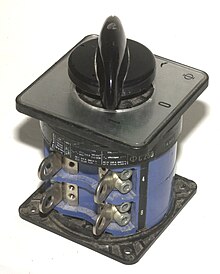Cam switches
The cam switches are electrical switches which are mainly used in the low-voltage network as main switches , for example for manual switching of electrical drives. They represent a robust design of the rotary switch . The essential feature is a camshaft made of abrasion-resistant conductive material which is attached to the interior of the switch and carries one or more electrical contacts . The contacts are opened or closed by turning this camshaft, the drive is carried out manually by an externally attached valve which also indicates the respective switching status. Often there are several cams on one shaft that switch or switch over several pairs of contacts at the same time.
The cam switch retained a certain importance in areas of electrical installations such as electrical distributors , where switching using a contactor is not more economical and remote control is not required.
history
Friedrich Natalis (1864–1935), who has worked at Schuckert-Werke (later Siemens-Schuckertwerke ) since 1897, is said to have developed the cam switch principle in Germany before 1900. However, as early as 1895, Johann Sigmund Schuckert , founder of the electrical engineering company Schuckert & CO, delivered step switches with cam rollers and individual switches under spring pressure (DRP 88586). Over the years, the term cam switch has become established for such and similar devices.
The cam switch probably did not find its way into small appliance construction until the early 1930s. In 1931 the American company General Electric GE released their SB1 switch, a 20 A auxiliary power control switch, basically a miniaturized replica of the large main power control switch. The devices had a single break and a silver contact switch, in some cases they were equipped with a snap mechanism.
In September 1948 Kraus & Naimer from Vienna delivered the first in-house cam switch of the type C15. In 1949, the company also presented the first cam switch in the world designed according to the modular principle. At the beginning of 1950 the Kraus & Naimer cam switch C30 followed with the same structure. The Kraus & Naimer cam switches C16 to C200 (16 / 200A), which came onto the market in the spring of 1951, had a decisive influence on the advance of the cam switch and the replacement of the roller switch in electrical engineering. They had double interruption and a motor switching capacity appropriate to the rated current . The large number of possible combinations and the extensive additional equipment as characteristic features were largely responsible for the later development of cam switches as an industrial standard.
Kraus & Naimer developed the world's smallest cam switch (model CA4N), which has been on the market since 1994.
Individual evidence
- ^ Walter Kaspers: Measure, control, and regulate . Springer-Verlag, 2013, ISBN 978-3-322-85947-1 ( google.at [accessed November 30, 2016]).
- ↑ Ose, Karl: Switching, controlling, protecting for 100 years: a contribution to the history of low voltage .
- ^ Kraus & Naimer - history. In: www.krausnaimer.at. Retrieved November 30, 2016 .
